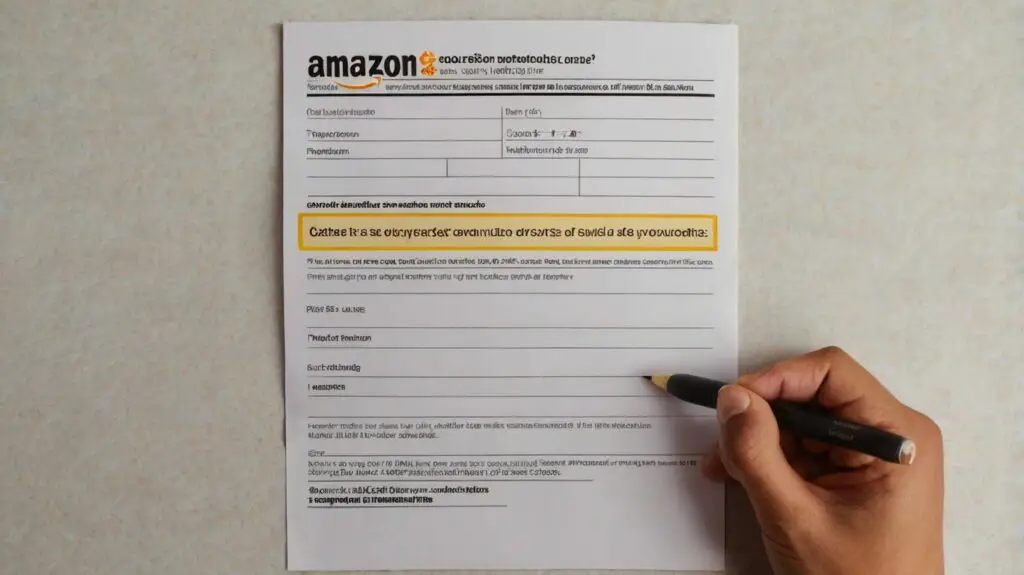Learn what the Amazon seller code of conduct is and how to avoid it to keep your account safe and growing. Simple tips for sellers.
🚨 Understand the Amazon Seller Code of Conduct Violation
If you’re an Amazon seller, violating the Seller Code of Conduct can have serious consequences like suspension, account deactivation, or even a permanent ban. This product breaks down what a violation means, the types of activities that trigger it, and why it’s critical to follow Amazon’s strict rules. From manipulating reviews to misrepresenting product information, the guide covers the key mistakes sellers make, often unknowingly. Understanding this now can save your business in the long run. Don’t take risks—educate yourself before it’s too late.
Keywords Used:
- Amazon seller code of conduct
- What is seller violation
- Amazon policy violation
- Seller account suspension
- Amazon marketplace rules
🛡️ How to Avoid Violating Amazon’s Code: Proven Strategies That Work
Learning how to avoid code of conduct violations on Amazon is just as important as knowing what they are. This guide provides actionable tips, real-life scenarios, and step-by-step strategies to stay compliant. Whether you’re a beginner or a seasoned seller, you’ll discover how to properly handle customer interactions, optimize listings truthfully, and use Amazon’s internal tools responsibly. Gain the peace of mind that comes with knowing you’re protected against surprise suspensions and ensure your business runs smoothly.
Keywords Used:
- Avoid Amazon violations
- Amazon seller tips
- Prevent Amazon suspension
- Seller code compliance
- Amazon sells best practices
💼 Protect Your Profits and Seller Reputation
Every seller on Amazon is building a brand. But one wrong move—like attempting to manipulate the Buy Box or using misleading titles—can harm your reputation, profits, and account health. This guide emphasizes the importance of ethical selling, transparent business practices, and how to maintain long-term success on the Amazon platform. With rising competition, you can’t afford to guess. Know exactly how to stay aligned with Amazon’s expectations, so your hard-earned profits aren’t lost to preventable mistakes.
📑 Table of Contents
- Introduction
- What Is Amazon’s Seller Code of Conduct?
- Why Does Amazon Have This Code?
- Common Amazon Violations That Sellers Commit
- Amazon Suspensions – What Triggers Them?
- What Happens If You Violate the Seller Code of Conduct?
- Top Reasons for Amazon Account Suspensions
- How to Avoid Seller Code of Conduct Violations
- How to Respond If You Are Suspended
- Best Practices for Sellers on Amazon
- How to Keep Your Amazon Seller Account Safe
- The Role of Amazon Seller Central
- Monitoring and Reporting Other Sellers
- Common Mistakes New Sellers Make
- Conclusion
- FAQs (10 Questions with Answers)
1. Introduction
Selling on Amazon can be a great way to earn money, but it also comes with strict rules. Amazon takes its marketplace seriously and expects sellers to follow the Seller Code of Conduct. If you break these rules, your account can get suspended—or even banned. This guide explains what the Seller Code is, the common violations, and most importantly, how to avoid Amazon suspensions. Think of it like the traffic rules on a busy highway. If you drive the wrong way, you’re putting everyone at risk—and Amazon won’t hesitate to take your keys away.
2. What Is Amazon’s Seller Code of Conduct?

The Amazon Seller Code of Conduct is a set of guidelines and rules that all sellers must follow. It helps keep the marketplace fair, honest, and safe for buyers and sellers. If you sell on Amazon Seller Central, you automatically agree to these rules. They are not just suggestions—they’re the law of the land for Amazon sellers. Violating them can lead to serious problems.
Here’s how Amazon expects sellers to behave:
- Always act fairly and honestly with Amazon, buyers, and other sellers.
- Avoid manipulating sales rankings or reviews.
- Don’t misuse customer information.
- Provide accurate product information.
- Fulfill orders reliably and on time.
Key points to remember:
- Treat buyers and Amazon with respect.
- Don’t cheat the system to gain unfair advantages.
- Deliver what you promise.
- Keep your communication professional and legal.
- Know that ignorance of the rules is not an excuse.
3. Why Does Amazon Have This Code?
Amazon has over 9 million sellers, and millions of customers. Imagine the chaos if sellers lied, sold fake items, or tricked the system. That’s why Amazon created the Seller Code of Conduct—to keep things clean, fair, and trustworthy. It helps protect customers and keeps the playing field equal for everyone. Amazon is all about customer trust, and it can’t risk that trust being broken by bad seller behavior.
Here’s why the code exists:
- To prevent fraud and scams.
- To protect customers from fake or dangerous products.
- To stop sellers from tricking the system.
- To keep Amazon’s reputation strong.
- To ensure fair competition among all sellers.
Reasons the code matters:
- Customers feel safer shopping on Amazon.
- Sellers compete fairly, not fraudulently.
- Amazon avoids lawsuits and bad press.
- It boosts buyer trust and return business.
- Rules create a healthy selling environment.
4. Common Amazon Violations That Sellers Commit

You may not intend to break Amazon’s rules, but even small mistakes can count as Amazon violations. Many new sellers don’t read the fine print or take shortcuts to boost sales. That’s a risky move. Amazon has smart systems and teams that detect these violations, even if you think they won’t notice.
Here are some common violations:
- Creating fake product reviews or offering incentives for them.
- Selling counterfeit or inauthentic goods.
- Using multiple seller accounts without permission.
- Changing product listings in dishonest ways.
- Violating pricing policies.
Watch out for these pitfalls:
- Don’t ask for 5-star reviews in exchange for freebies.
- Always provide real, branded products.
- Never operate more than one account without approval.
- Keep your listings truthful and complete.
- Follow pricing rules to avoid penalties.
5. Amazon Suspensions – What Triggers Them?
Amazon suspensions happen when a seller breaks the rules. It doesn’t always happen immediately, but when it does, it can shut down your income instantly. One minute you’re making sales, the next, you can’t even log in. Amazon takes violations seriously, especially repeated ones or those that hurt customer trust.
Here are some triggers for suspension:
- Sudden spike in order defect rate or customer complaints.
- Repeat violations of the Seller Code.
- Selling prohibited or unsafe products.
- Failing to deliver on time.
- Abusing the review system.
Behaviors that cause suspensions:
- Late shipments or canceled orders.
- Ignoring customer messages and returns.
- Listing items under the wrong category.
- Shipping used items as new.
- Using click farms or bots to boost sales.
6. What Happens If You Violate the Seller Code of Conduct?

If Amazon suspects that you broke the Seller Code of Conduct, it doesn’t always give a warning. Sometimes, it instantly suspends or even bans your account. And once that happens, it’s not easy to get back. Your payments may be held, and you may lose access to Seller Central. You’ll need to create a solid appeal or Plan of Action to convince Amazon to reinstate your account.
What to expect if you violate the code:
- Immediate account suspension or deactivation.
- Funds held for 90 days or more.
- Loss of access to customers and order history.
- Damage to your brand and business reputation.
- Long and stressful appeal process.
Consequences you may face:
- No new sales or traffic.
- Negative customer feedback.
- Increased refund or chargeback requests.
- Legal risks if you sold restricted items.
- Permanent ban if violations are serious or repeated.
7. Top Reasons for Amazon Account Suspensions
Understanding the top reasons sellers get suspended helps you avoid falling into those traps. Some are obvious, like selling fake products, but others are less known—like having too many late shipments or using copyrighted content in listings.
Top causes for suspensions:
- High order defect rate (ODR) or poor customer service.
- Review manipulation or fake feedback.
- Selling inauthentic or restricted items.
- Duplicate accounts without Amazon’s approval.
- Violating product listing guidelines.
Big red flags to avoid:
- Too many customer complaints in a short time.
- Failing to respond to buyer messages within 24 hours.
- Creating misleading product titles or descriptions.
- Selling used items as “new.”
- Uploading someone else’s images or text.
8. How to Avoid Seller Code of Conduct Violations
Avoiding Amazon violations is not hard if you stay honest, follow the rules, and focus on giving great service. The key is to know the Seller Code of Conduct inside out and keep up with changes Amazon makes. Prevention is better than suspension—it saves you stress, time, and money. Remember, Amazon rewards good behavior, not shortcuts or tricks.
Here’s how you can stay safe as a seller:
- Read and follow all Amazon policies regularly.
- Be honest in your listings and product claims.
- Use only real customer feedback.
- Ship on time and communicate well with buyers.
- Monitor your performance metrics on Seller Central.
Tips to avoid getting into trouble:
- Never offer rewards for reviews—it’s against Amazon policy.
- Don’t copy descriptions or images from competitors.
- Always use tracking numbers for shipments.
- Don’t list restricted or counterfeit items.
- Keep your inventory updated to avoid canceling orders.
9. How to Respond If You Are Suspended
Getting suspended can feel like a nightmare, but it’s not always the end. If your Amazon Seller account gets suspended, the most important step is to stay calm and create a strong Plan of Action (POA). Your POA should show Amazon that you understand what went wrong, that you’ve fixed it, and that it won’t happen again.
What to do if you’re suspended:
- Review the reason for suspension carefully.
- Gather evidence and account details.
- Write a clear, honest Plan of Action.
- Submit the appeal through Seller Central.
- Wait patiently and respond if more info is needed.
Steps to increase your appeal chances:
- Admit the mistake if you made one.
- Avoid blaming Amazon or buyers.
- Be specific—general statements don’t help.
- Show proof of changes (like updated product images).
- Ask for guidance if your appeal is denied.
10. Best Practices for Sellers on Amazon
If you want long-term success on Amazon, you must play by the rules. That means more than just avoiding violations—it means being a top-quality seller. Follow best practices that help you stand out while staying safe. Think of it like being a student in class: do your homework, follow the rules, and earn extra credit by going the extra mile.
Best habits to follow:
- Check your account health dashboard weekly.
- Update your listings regularly with clear, honest info.
- Reply to customer messages within 24 hours.
- Offer a great return policy and resolve issues fast.
- Keep learning Amazon’s policies and news.
Ways to be a top-tier seller:
- Use Fulfilled by Amazon (FBA) for reliable shipping.
- Optimize product listings with quality images.
- Ask buyers for honest feedback—but don’t offer rewards.
- Keep your pricing competitive and fair.
- Review your performance reports monthly.
11. How to Keep Your Amazon Seller Account Safe
The best way to avoid Amazon suspensions is by building strong selling habits. Prevention is key. If you set up your account the right way, follow all policies, and stay organized, you’ll likely never face a suspension. Treat your Amazon account like a treasure—because it is!
Here’s how to protect your account:
- Turn on 2-step verification for security.
- Check your performance metrics often.
- Avoid shared networks or IPs with other sellers.
- Never open multiple accounts without approval.
- Keep complete documentation for your inventory.
Things to do regularly:
- Audit your listings every month.
- Watch your return rate and bad reviews.
- Remove or update outdated products.
- Double-check your order processing time.
- Get training or support when needed.
12. The Role of Amazon Seller Central
Amazon Seller Central is your control panel. It’s where you manage orders, track performance, answer customer questions, and handle suspensions if they happen. Knowing how to use this tool well can help you avoid Seller Code of Conduct violations. It’s like the cockpit of your Amazon business—master it!
What you can do in Seller Central:
- Monitor account health and violation warnings.
- View performance metrics (like ODR and late shipment rate).
- Manage listings, inventory, and prices.
- Appeal suspensions and upload POAs.
- Communicate with Amazon support teams.
Helpful Seller Central features:
- Performance notifications (check daily).
- Inventory planning and stock alerts.
- Business reports to analyze sales trends.
- Customer feedback and review sections.
- Access to seller training and tools.
13. Monitoring and Reporting Other Sellers
Sometimes, sellers break the rules and hurt your business by cheating. You can help keep the marketplace clean by reporting bad behavior. Amazon takes these reports seriously, but only if they are real and well-documented. Don’t report sellers out of spite—it must be honest and backed by evidence.
Here’s how to report violations:
- Gather screenshots or order details.
- Go to Seller Central, find “Report a Violation.”
- Submit a detailed report to Amazon.
- Wait for confirmation or updates.
- Don’t harass or contact the other seller.
Why reporting helps everyone:
- Stops counterfeit or fake products.
- Helps protect customer trust.
- Makes the marketplace fairer.
- Discourages rule breakers.
- Shows Amazon you care about quality.
14. Common Mistakes New Sellers Make
Starting on Amazon is exciting, but it’s easy to make mistakes that can lead to suspensions. Many new sellers rush in without reading the rules. But knowledge is power—learning from others’ mistakes can save you from costly errors.
Frequent beginner mistakes:
- Not understanding the Seller Code of Conduct.
- Selling without product research.
- Using poor-quality product images.
- Ignoring customer service or reviews.
- Violating pricing or shipping policies.
How to avoid newbie errors:
- Spend time studying Amazon policies.
- Test one or two products first—don’t launch 50.
- Take your own pictures, don’t copy others.
- Respond to every customer, even negative ones.
- Don’t try to “game” the system—it backfires.
15. Conclusion
Selling on Amazon is a great opportunity—but only if you follow the rules. The Seller Code of Conduct is there to protect buyers, sellers, and Amazon itself. Don’t treat it like optional advice—it’s a serious set of policies. Violations can cost you money, reputation, and even your account. But the good news? You can avoid all of this by staying honest, professional, and proactive. Keep learning, use Seller Central wisely, and make customer trust your number one priority. Amazon rewards those who play fair—and punishes those who don’t. Choose wisely.
FAQs
1. What is the Amazon Seller Code of Conduct?
It’s a set of rules that all Amazon sellers must follow to ensure fair and honest selling on the platform.
2. Can I get suspended without warning?
Yes. If the violation is serious, Amazon may suspend your account without prior notice.
3. What should I do if my account is suspended?
You should review the violation notice, create a detailed Plan of Action, and submit it through Seller Central.
4. Can I use multiple Amazon seller accounts?
Only with written permission from Amazon. Having multiple accounts without approval can lead to suspension.
5. What are common violations?
Fake reviews, counterfeit items, poor shipping practices, and misleading product listings.
6. How do I improve my seller performance?
Offer excellent customer service, ship on time, and keep your listings accurate and clear.
7. Is it okay to offer free products for reviews?
No. This is considered review manipulation and is against Amazon’s rules.
8. How can I monitor my account health?
Use the Account Health Dashboard in Seller Central to view key metrics and warnings.
9. What happens to my money if I’m suspended?
Amazon may hold your funds for up to 90 days during the investigation.
10. How do I contact Amazon if I need help?
Log into Seller Central and open a case with Seller Support for guidance.
